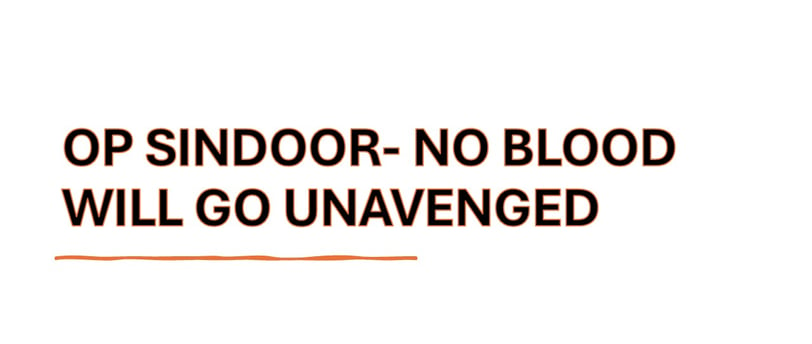Pahalgam Ignites the Fire: India’s Retaliation Echoes Across the Border
How Pahalgam became the tipping point and how India's retaliation sent a chilling message to those who dared to challenge its sovereignty.
DEFENCE INSIGHTS
5/7/20254 min read


When the serene town of Pahalgam, nestled in the valley of Kashmir, witnessed a brutal terrorist attack, the ripples were felt not only across India but also reverberated through diplomatic corridors and military command centers. The blood spilled on that day did not just stain the snow — it ignited a flame. What followed was not mere condemnation, but a calculated, resounding response that shook the foundations of terror infrastructure across the border. This is the story of how Pahalgam became the tipping point and how India's retaliation sent a chilling message to those who dared to challenge its sovereignty.
The Calm Before the Storm
Pahalgam is often known for its postcard beauty and spiritual significance. But on that fateful day, its silence was shattered by gunfire and explosions. Militants, heavily armed and well-trained, ambushed a military convoy, killing several jawans and injuring dozens. Civilians, too, were caught in the crossfire, their peaceful lives upended in an instant.
The nation watched in horror. Social media erupted. Anger, grief, and calls for retribution filled the air. But unlike previous times, this time felt different. The country was no longer willing to swallow platitudes. Action was imminent.
Behind the Closed Doors
Within hours, top military brass, intelligence chiefs, and government leaders were in high-level meetings. The National Security Council met behind closed doors, examining satellite imagery, intercepted communications, and human intelligence reports. The conclusion was clear: the attack bore the hallmarks of a Pakistan-sponsored operation.
It wasn't just another attack; it was a strategic provocation. And it demanded a strategic response.
The Birth of Operation Sindoor
Named symbolically after the sacred red mark that signifies protection and justice in Indian tradition, Operation Sindoor was conceived as a surgical, zero-intrusion mission. The objective was clear: eliminate terror launchpads, disrupt command chains, and strike deep into enemy territory without a single Indian soldier crossing the Line of Control (LoC).
Precision munitions, stand-off weapons, and high-altitude drones were prepped. Intelligence was verified thrice over. The countdown had begun.
The Night the Sky Spoke
At exactly 1:28 AM, multiple high-speed projectiles sliced through the sky. Indian Air Force fighters, supported by satellites and surveillance drones, launched a coordinated attack on at least seven identified terror hubs in Pakistan-administered territory.
Bunkers housing Jaish-e-Mohammed and Lashkar-e-Taiba operatives were reduced to rubble. Ammunition dumps exploded like firecrackers. Entire training camps went radio silent. Pakistani radars were jammed before they could react.
On ground zero, the chaos was absolute. And across the LoC, India watched — calm, calculated, and deadly.
Echoes in the Diplomatic Arena
As news of the strike broke, Pakistan predictably denied everything. Their state media termed it "an Indian fabrication." But satellite images told a different story. Craters, destroyed facilities, intercepted panic calls — the evidence was irrefutable.
India, meanwhile, unleashed its diplomatic corps. Ambassadors were briefed. The UN was approached with dossiers. Key allies were shown classified intel. Most importantly, the narrative was seized: this was not war; it was self-defence. And justice.
The Cyber and Info War
Operation Sindoor was not just a military maneuver; it was a multidimensional strike. Even as bombs fell, Indian cyber units launched offensives on propaganda servers, disrupting communications used to recruit and radicalize.
At home, the Information & Broadcasting Ministry rolled out a parallel narrative war. Videos of soldiers. Testimonies of victims. And raw footage of destroyed terror camps. The goal was to counter disinformation and galvanize public morale.
The message: India stands united.
Pakistan’s Predicament
Cornered on the military front, exposed on the global stage, and internally rattled by economic woes, Pakistan found itself on the backfoot. Its leadership scrambled for damage control. A few stray artillery rounds were fired across the LoC, but they were met with overwhelming Indian retaliation.
Diplomatic allies like China and Turkey offered mild support but stopped short of endorsing Islamabad's narrative. The Financial Action Task Force (FATF) meetings loomed closer, and the last thing Pakistan needed was more evidence of terror complicity.
Voices from the Valley
Back in Pahalgam, the aftermath of the attack was still raw. But amid the sorrow, a strange sense of vindication emerged. Locals, often caught between politics and extremism, felt the shift. Schools reopened. Army units conducted medical camps. Youth volunteers organized peace marches.
"We are not just victims," said one young resident. "We are the reason justice came."
Global Reactions and Realignments
World leaders reacted with a mix of caution and acknowledgment. The U.S. State Department reiterated India’s right to self-defence. European nations urged de-escalation but refrained from condemning the strike. Russia supported India's fight against terror unequivocally.
More significantly, defence analysts worldwide took note. India’s retaliation had shown how modern warfare could be swift, digital, and devastating — without boots crossing borders.
What Lies Ahead
The India-Pakistan conflict is far from over. But Pahalgam changed the playbook. No longer will India wait passively. With Operation Sindoor, a new doctrine emerged — fast, precise, and unrelenting.
Pakistan may choose to escalate or back down, but one thing is clear: the cost of provocation has gone up. And in the subcontinent, that changes everything.
From Ashes, a New Resolve
Pahalgam may have been the site of tragedy, but it also became the crucible of resolve. India did not just avenge its fallen; it sent a message to every actor in the game — state or non-state.
No attack will go unanswered. No blood will go unavenged.
And justice, though delayed, will always find its mark.
This is not just a tale of retaliation. It's a story of a nation reclaiming its red line — drawn not in sand, but in steel.
